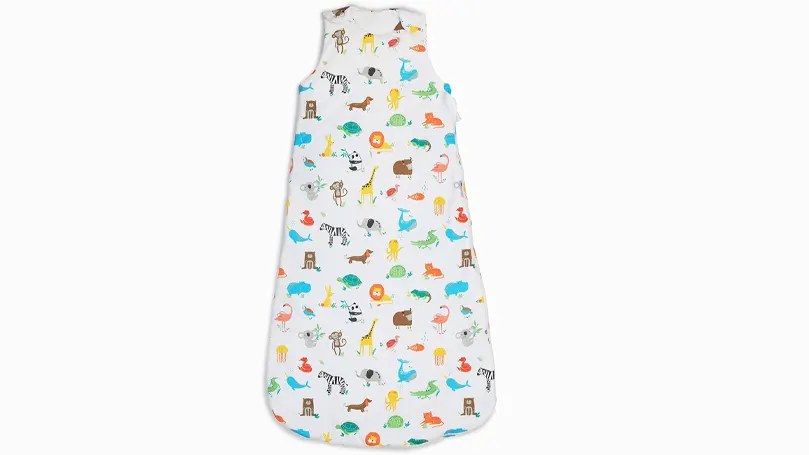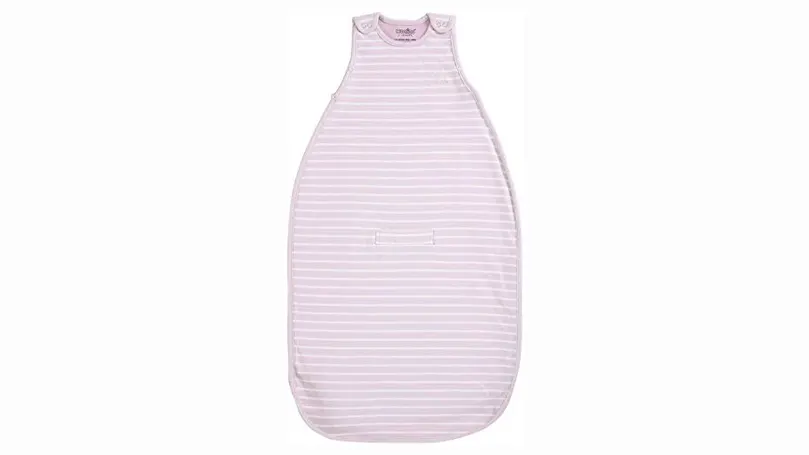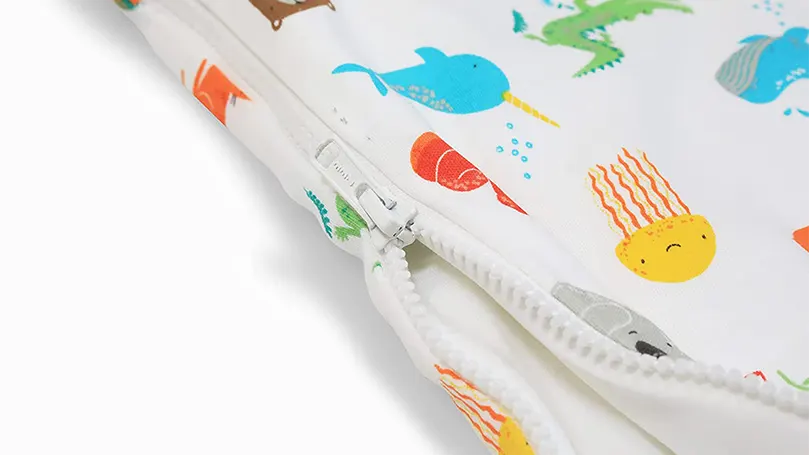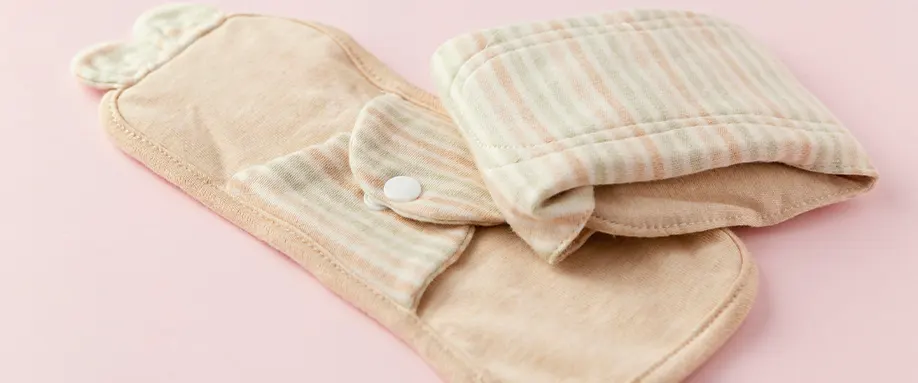Benefits of a baby sleep bag
Before we get deeper into our baby sleeping bag guide, we first have to understand the benefits of using a baby sleep bag. Otherwise, what's the point of even getting one?

No overheating/cold
First things first, baby sleep bags are temperature-regulating. They're like a wearable blanket. This means that they will prevent your baby from overheating or getting too cold during the night.
Unlike blankets, which can be kicked off (and cause your baby to wake up from the sudden change in temperature), sleep bags are designed to keep your baby at a comfortable temperature all night long.
This is important because the temperature is one of the key factors. It determines whether or not your baby sleeps through the night. If they're too hot or too cold, they'll wake up and won't be able to fall back asleep.
To make sure they're not cold or overheating, you can check the baby's chest. Also check baby's skin on the back of the neck and see if it feels hot or cold to touch.
No additional covers needed
Most of the time, you won't need to use any additional covers or extra baby wear with a baby sleep bag. This is because they're usually made from thick, quilted fabric that's designed to trap heat.
However, in the summer months, you might want to use a light cotton sleep bag to keep your baby cool – but more on that later.
In any case, using a sleeping bag will save you the trouble of having to find (and then wash) extra blankets and sheets.
Peaceful sleep
It's all about this one. A good night's sleep is crucial for your baby's development, and a baby sleep bag can help make that happen.
As we mentioned before, the snug fit of a sleeping bag relaxes babies and makes them feel secure – two key ingredients for a good night's sleep.

Great for travelling
Finally, if you're often on the road, a baby sleep bag is a godsend. Not only will it help your baby sleep better in unfamiliar surroundings, but it will also save you the trouble of packing a separate blanket and sheet for each night.
It will also make them feel snug whether they're in a car, a booster seat, in your lap on an aeroplane, or even in a stroller.
Does baby sleep bag TOG matter?
When it comes to TOG ratings and sleeping bags, there is no one perfect answer. Depending on the climate and room temperature, a different TOG sleeping bag may be more appropriate.
In warmer weather, a lower TOG rating would be ideal, while in cooler weather a higher TOG rating would be more comfortable for the baby. But that's just general ground rules.
On a more detailed note, the TOG rating is a measure of the thermal resistance of an insulating product. It’s basically a way to know how well a sleep sack will keep your baby warm in different temperatures. Therefore, the lower the TOG, sleeping bags' cooler to sleep in.

So when it comes to warm summer months, a sleeping bag TOG rating of 0.5 or 1 would be ideal. Again, this depends on the climate as well as the temperature in the baby’s sleep space.
On that same note, for the winter months, you’d want to go with a higher TOG rating – something like 2.5 TOG or maybe even 3.5.
But, that's not the end of the story. There's still a matter of clothing. You see, in cooler weather, the baby may need long sleeve cotton pyjamas underneath her sleep sack as well, so always check the TOG rating as well as the temperature in the sleep space to make sure the baby is safe and comfortable while it's resting in its Moses basket.
Now that you know all there is to know about baby sleep sacks and the right TOG sleeping bag rating for constant temperature year round, it's time for a final piece of the puzzle – check it out!
Tips when buying a baby’s sleeping bag
Another important bit is learning how to choose the most suitable sleeping bag for your baby. Here are some general tips to help you out.
Look for BS 8510:2009 standard
When shopping for a baby’s sleeping bag, it’s important to look for one that meets the BS 8510:2009 safety standard. This is the British safety standard for sleeping bags and ensures that the bag will not cause any harm to your baby.
This is absolutely vital as you want to make sure that your baby is safe and comfortable at all times.
Get a bag with detachable sleeves and hood
A bag with detachable sleeves and a hood is also a great choice as it allows you to adjust the amount of coverage and insulation your little one gets. This way, you can keep your baby comfortable in any weather.

Armholes need to be snug
It's vital your baby stays safe throughout the night, so make sure the arm holes of the bag are snug. Since you're not swaddling them, the baby's arms will be free to move around, so you don't want to risk them being able to squeeze their hands in a bag and potentially injure themselves.
Choose the right size
When it comes to sleeping bags, size definitely matters. You want to make sure that the bag is not too big or too small for your baby. A good rule of thumb is to buy a bag that is about 10 cm longer than your baby's body. This way, they will have plenty of room to move their legs around, but at the same time, stay perfectly safe and snug.
So, whatever you do, don't get a bag your baby will “grow into”. It doesn't work that way. As your baby grows, you can buy larger bags so that they can continue to use them.
Look for smooth edges, zippers & seams
You want to make sure that the bag you choose has smooth edges, zippers and seams. This is important as you don't want your baby to get caught on anything or have any sharp edges poking into their skin.

Ideally, you also want to make sure that the zippers are covered so that your baby can't accidentally scratch themselves with them. They'll use their sharp nails for scratching, they don't need anything else.
The neck hole shouldn’t be too big
As for the neck hole, you want to make sure that it's not too big. If the neck hole is too big, your baby might be able to wiggle their way out of the bag and put themselves at risk of injury.
At the same time, you don't want the neck hole to be too small as this can make it difficult for your baby to breathe or have a hard time getting in and out of a bag.
The bottom line is, you want the neck hole to be just big enough for your baby's head to fit through comfortably.
Are baby sleep bags recommended?
Actually, they are.
Many paediatricians and experts recommend the use of baby sleep sacks as they provide a safe and comfortable environment for your little one to sleep in.
They are also great for babies who are transitioning out of swaddles as they provide the same level of comfort and security without the restrictions of being swaddled.
But, most importantly, sleeping bags lower the chance of SIDS, which is arguably the most important reason to use one.

What is the appropriate age for my baby to use baby sleep bags?
You shouldn't rush into it. For the first three months, stick with swaddling. After your baby turns three months old, you can start to slowly transition them into baby sleeping bags.
Start by using the sack for naps during the day and then eventually use it for nighttime sleep as well. Keep in mind that every baby is different, so some may take to the sleep sack right away while others may need a little more time to adjust.
The important thing is to take your time and do what's best for your baby.
Do babies' arms get cold in sleeping bags?
No, not at all. As long as you dress babies properly, their arms will be just fine. If your baby does get cold, you can always use warmer PJs or put a blanket over the top of the baby sleeping bag. Just make sure that the blanket is lightweight so that your baby doesn't get too hot.















There are no comments yet
"*" indicates required fields